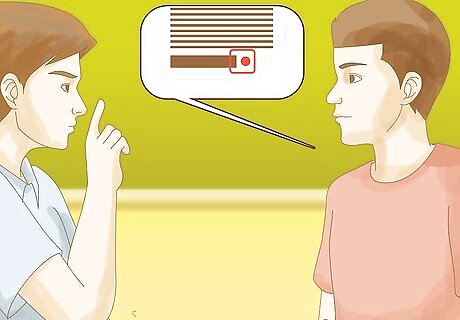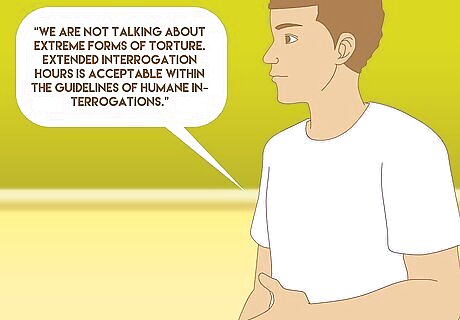
views
Deciding Whether to Answer or Decline a POI

Plan on when to accept POIs during your argument. Before giving your argument, determine where in your speech will be the best times to address POIs and only accept them during those times. The best time to accept POIs is during the parts of your speech where you are most confident and knowledgeable. Most debate formats will require you to take at least two POIs during your argument. There are advantages and disadvantages to taking both POIs at the beginning, at the end, or spreading them out. Taking both POIs towards the beginning of your argument will get them out of your way, allowing you to focus on the substance of your idea for the rest of your time without worry of being interrupted. However, taking both POIs early can delay getting into the substance of your ideas and may create problems if you don’t manage your time well for the rest of your speech. Waiting until the end of your speech to accept both POIs can be an advantage because they will come during the strongest times in your argument, giving you a position to answer them. However, delaying acceptance of any POIs until the end may discourage your opponents from asking them, leaving you with no POIs to answer. Spreading POIs out between the first and last parts of your argument will demonstrate to the judges that you are comfortable addressing POIs at any point in your argument. However, don’t forget to address the second POI in the latter half of your time.

Acknowledge your opponent when they raise a POI. How your opponent will raise a POI will depend on what style of debate you are using. There are many different styles of debate; however, they have many commonalities. Most often, your opponent will raise a POI by standing, raising their hand, and/or saying “Point of Information,” “POI,” “On that point,” or another accepted phrase. You will usually have a period of time at the beginning and the end of your argument during which your opponent is restricted from raising POIs. The amount of time is determined by the style of debate you’re using.

Finish your sentence or thought before addressing the opponent’s POI. Even when a POI is raised, remember that you are still the one in control. Do not let the opponent derail your argument by raising a POI. Address the POI once you’ve completed your sentence or idea.

Decline the POI if you believe a disruption will undermine the effectiveness of your argument. If you are in the middle of a strong and passionate section of your argument, do not let a POI ruin your momentum. Also, do not accept a POI during a particularly weak section of your argument, which could be easily attacked by your opponents. To decline a POI, you can verbally tell them you will not accept a POI at this time by saying, “No, thank you,” or “Not at this time, thank you.” Alternatively, you can wave them down by waving your hand in a gesture towards the ground. How you decline a POI is determined by your personal preference, but waving an opponent down may be less disruptive to the flow of your argument.

Accept the POI by saying “Accepted,” “Yes, please,” or “Go ahead.” After you accept the POI, your opponent typically has no more than 15 seconds to raise their objection or question. If your opponent speaks for longer than the allotted time, ask them to sit down. POIs may be posed as a pointed question, a rhetorical question, or a concise statement. POIs commonly challenge an argument in one of three ways: Pushing the premise of your argument to its logical extent. This strategies tries to force you to defend extreme examples. For example, “If you approve of advanced interrogation techniques, then you must approve of the use of waterboarding and other forms of torture.” Questioning the credibility of a fact. In instances where your argument is dependent on certain facts, a POI that undermines the credibility of that fact could undermine your entire argument. This type of POI may be structure like this one: “You argue that lowering tax rates is effective in increasing a state’s overall tax revenue, but Smith showed that states which lowered tax rates had diminishing tax revenue.” Proposing a baited contradiction. Common practice of this strategy takes the form of an opponent asking you to take a stance on an issue that he knows will be contradicted in his own or one of his teammate’s upcoming speeches. Such as, “Are you okay with lifting the embargo on Cuba?”
Responding to a POI

Answer the POI. Once you’ve decided to accept a POI, you must respond to it, even if your speech will address the issue later in your time. Don’t dismiss the POI by saying “I’ll get to that later.” The argument you have planned may not directly answer the POI, or you may forget about it altogether. Instead, address the POI succinctly and say you will expand on those ideas later in your talk. How you respond to the POI should be dependent on the strategy your opponent used in posing it.

Keep your response within the scope of your original argument. If the POI pushes the premise of your argument to its logical extent, remind your audience that the proposed scenario is beyond the scope of your argument. You could respond, “We are not talking about extreme forms of torture. Extended interrogation hours is acceptable within the guidelines of humane interrogations.”

Question the credibility of the POI’s facts. If the POI questions the credibility of your facts, you may choose to respond to calling into question the opponent’s own sources. A response to this type of POI could be, “Smith’s study of tax revenue was soundly discounted by many leading economists, including Wilson, Lee, and Jones.”

Anticipate your opponent’s counterargument. When responding to a potentially baited contradictions, keep your answer within the parameters of your argument and expect that your opponent’s counterargument will address this issue. You could say something like this: “Yes, the embargo against Cuba should be lifted, but only if and when the Cuban regime agrees to our terms.”

Remain confident even if you don’t know how to respond to a POI. You will likely face a time when you are unable to respond to a POI because you do not know the answer to the question or cannot think of an adequate rebuttal. When possible, reiterate the positive aspects of your argument. Alternatively, point out the shortcomings of the question. When you’re attacking the shortcomings of the POI, you could structure your response like this: “Your implication that extended interrogation hours is equivalent to waterboarding is ridiculous and totally blown out of proportion. We’re not talking about torture. We’re talking about giving police the necessary tools to acquire the most information about a crime as possible in a timely fashion.” Don’t appear flustered by stalling with phrases like “Um” and “Uh, well, maybe.” Even a faulty POI can look strong if you become nervous and agitated while trying to respond.

Address the audience and judges. When you are asked a POI, remember that you are still speaking to the audience. Don’t turn your attention to the opponent asking the POI. You are not having a private side-conversation with the opponent. Keep your body posture and voice level consistent with delivering the main body of your argument.

Do not walk towards your opponent as they deliver their POI. Approaching your opponent while they are speaking can be perceived as an aggressive act, and the audience may believe you are trying to bully your opponent. Instead, maintain your position and focus on the content of the POI.
Resuming Your Argument

Respond to the POI concisely. You have a set amount of time for your argument during a debate. Do not allow the opponent to knock you off your rhythm by giving a lengthy response to a POI. Address the point clearly, but briefly so that you can return to your prepared argument.

Make a note of where you are in your speech when you accept a POI. If you have a pen in your hand, mark the point in your speech where you stopped to address the POI. If you do not have a pen handy, place your finger on the appropriate spot in your notes, or make a mental note of where you left off. This will help you quickly resume your argument, and you will not be fumbling with your notes trying to find where you left off.

Transition from the POI to your argument smoothly. Remind the audience and the judges how the POI connects back to your argument at hand. Use transitional phrases like, “This connects back to what I was saying before,” or “I’m going to return to this idea in a moment.” Transitioning back to your ideas places the emphasis on your own argument as you move forward in your ideas.


















Comments
0 comment